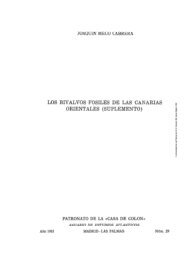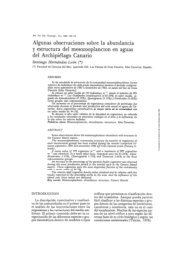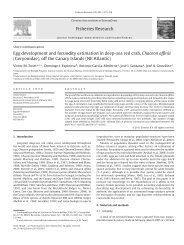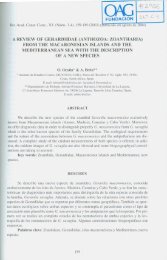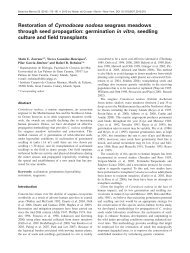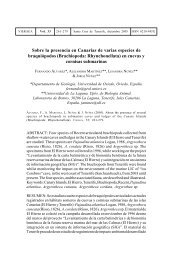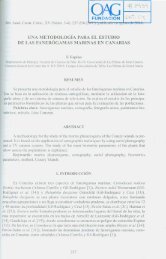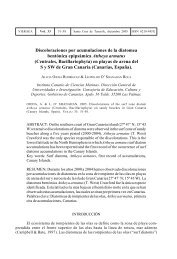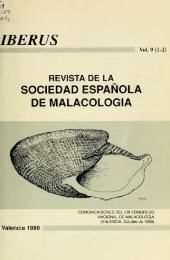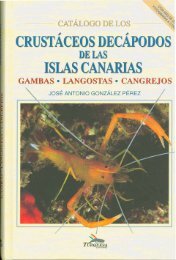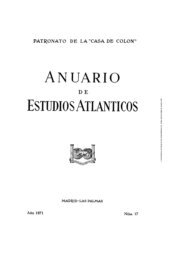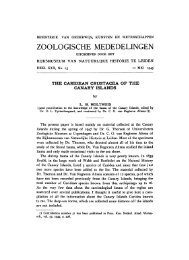of the madeira and selvagens archipelagos - redmic
of the madeira and selvagens archipelagos - redmic
of the madeira and selvagens archipelagos - redmic
Create successful ePaper yourself
Turn your PDF publications into a flip-book with our unique Google optimized e-Paper software.
1. Introdução<br />
Os briófitos, pelas suas dimensões e insignificante aspecto,<br />
não despertam a atenção do público em geral. Os<br />
briófitos constituem, no entanto, um componente importante<br />
da vegetação de muitas regiões do mundo. De facto,<br />
estes organismos formam a maior parte da biodiversidade<br />
em habitats de tundra, zonas húmidas, florestas húmidas e<br />
zonas de montanha, desempenh<strong>and</strong>o um papel vital nesses<br />
ecossistemas. Nas florestas temperadas, por exemplo, os<br />
briófitos formam comunidades mistas em gr<strong>and</strong>es extensões<br />
e contribuem significativamente para a estrutura das<br />
comunidades e funcionamento dos ecossistemas. Os briófitos<br />
são sensíveis a flutuações naturais de humidade e do regime<br />
hídrico, e ao contrário das plantas com flor, os briófitos<br />
não têm cutícula foliar, o que provoca um instantâneo ganho<br />
ou perda de água, isto é, podem absorver pequenas quantidades<br />
de água de nevoeiros, neblinas e orvalho que outras<br />
plantas (com cutícula) não conseguem aproveitar, mas em<br />
geral perdem a água facilmente. Com a captação e a disponibilização<br />
de água no meio, os briófitos contribuem para a<br />
manutenção de microambientes húmidos e para a regulação<br />
do fluxo hídrico nos ecossistemas. Estas propriedades dos<br />
briófitos são de extrema relevância, pois permitem a entrada<br />
gradual de água nos cursos de água, evit<strong>and</strong>o a ocorrência<br />
de cheias súbitas, a erosão do solo e o deslizamento de<br />
terras. Neste último século, além de previsíveis alterações<br />
ambientais, incluindo as mudanças climáticas, assiste -se a<br />
uma rápida substituição de florestas naturais e seminaturais<br />
(com gr<strong>and</strong>e biodiversidade) por florestas com elevado valor<br />
económico (pobres em biodiversidade). Os briófitos são<br />
extremamente sensíveis a alterações climáticas e de uso<br />
do solo, podendo ser utilizados como indicadores de continuidade<br />
ecológica e da qualidade ambiental. Deste modo,<br />
o conhecimento da distribuição dos briófitos e os factores<br />
ambientais que os afectam constituem uma importante base<br />
de conhecimento que pode vir a ser utilizada para prever as<br />
alterações ambientais nos ecossistemas.<br />
Os arquipélagos da Madeira e das Selvagens estão localizados<br />
no Oceano Atlântico, na intersecção dos trópicos, da<br />
América do Norte e da Europa. O seu isolamento geográfico,<br />
assim como a ocorrência de uma gr<strong>and</strong>e diversidade de habitats<br />
associada a uma gr<strong>and</strong>e variação altitudinal, favoreceram<br />
o desenvolvimento de uma biodiversidade muito particular,<br />
incluindo uma bri<strong>of</strong>lora rica, com formas e estratégias<br />
de vida peculiares, que origaram alguns endemismos e ou<br />
taxa importantes sob o aspecto fitogeográfico.<br />
A ilha da Madeira apresenta uma gr<strong>and</strong>e diversidade de<br />
habitats e os briófitos existentes ou apresentam uma gr<strong>and</strong>e<br />
distribuição geral ou correspondem a taxa relíquia ou paleo-<br />
-endemismos (Sérgio 1984) ligados a habitat particulares.<br />
Por outro lado, existem desde o nível do mar até zonas de<br />
gr<strong>and</strong>e altitude, desempenh<strong>and</strong>o um papel importante na<br />
colonização, estabilidade e dinâmica dos ecossistemas<br />
(Fontinha et al. 2006). Entre os ecossistemas terrestres presentes<br />
nesta ilha, destaca -se a valiosa Laurissilva, uma das<br />
florestas perenes laurifólias mais bem preservadas da Ma-<br />
124<br />
1. Introduction<br />
Bryophytes are inherently small <strong>and</strong> inconspicuous<br />
plants that do not get much attention from <strong>the</strong> general public.<br />
However, bryophytes are an important component <strong>of</strong><br />
<strong>the</strong> vegetation in many regions <strong>of</strong> <strong>the</strong> world. They play a<br />
vital role in, <strong>and</strong> constitute a major part <strong>of</strong>, <strong>the</strong> biodiversity<br />
in humid forest, wetl<strong>and</strong>, mountain, <strong>and</strong> tundra ecosystems.<br />
In temperate forests, for example, bryophytes form extensive<br />
mixed communities <strong>and</strong> contribute significantly to<br />
<strong>the</strong> community structure <strong>and</strong> ecosystem functioning. These<br />
organisms are sensitive to natural fluctuations in humidity<br />
<strong>and</strong> water regime. Unlike flowering plants, bryophytes lack<br />
a leaf cuticle <strong>and</strong> are <strong>the</strong>refore capable <strong>of</strong> quickly gaining<br />
<strong>and</strong> loosing water. This means that bryophytes dry out very<br />
quickly, but <strong>the</strong>y can also absorb minute quantities <strong>of</strong> available<br />
moisture from fog, mist <strong>and</strong> dew -sources <strong>of</strong> water<br />
that o<strong>the</strong>r plants cannot use. They slowly release water into<br />
<strong>the</strong> surrounding environment, <strong>and</strong> can <strong>the</strong>refore contribute<br />
to <strong>the</strong> retention <strong>of</strong> humid forest microclimates <strong>and</strong> to <strong>the</strong><br />
regulation <strong>of</strong> water flow. Perhaps most importantly, <strong>the</strong>se<br />
properties allow forests to gradually release water into watercourses,<br />
preventing flash floods, erosion, <strong>and</strong> downstream<br />
l<strong>and</strong>slides. Environmental changes are predicted for this<br />
century, including climate changes <strong>and</strong> <strong>the</strong> conversion <strong>of</strong><br />
ancient natural <strong>and</strong> semi -natural forests with a high biodiversity<br />
into commercial forestry, which is commonly low on<br />
biodiversity. In this context, bryophytes can be used as indicators<br />
<strong>of</strong> ecological continuity <strong>and</strong> research considering <strong>the</strong><br />
bryophyte distribution <strong>and</strong> environmental factors that may<br />
affect it, will constitute an important database for future<br />
evaluation <strong>of</strong> <strong>the</strong> main changes in this sensitive vegetation<br />
as well as for <strong>the</strong> assessment <strong>of</strong> environmental quality.<br />
The Madeira <strong>and</strong> Selvagens <strong>archipelagos</strong> are located in<br />
<strong>the</strong> Atlantic Ocean, at a point <strong>of</strong> intersection between <strong>the</strong><br />
tropics, North America <strong>and</strong> Europe. Its geographical isolation,<br />
as well as <strong>the</strong> occurrence <strong>of</strong> a large altitudinal range<br />
<strong>and</strong> diversity <strong>of</strong> habitats, implies a diverse Bry<strong>of</strong>lora with<br />
very peculiar forms including all life -form strategies, giving<br />
rise to some endemics. Many bryophytes <strong>of</strong> Madeira present<br />
a wide distribution, while o<strong>the</strong>rs, including palaeo-endemics<br />
<strong>and</strong> relict taxa, have a more restricted distribution<br />
usually associated with specific habitats (Sérgio 1984).<br />
Madeira Isl<strong>and</strong> in particular, harbours a high diversity <strong>of</strong><br />
habitats where bryophytes occur, from sea level to <strong>the</strong> highest<br />
mountains, playing an important role in <strong>the</strong> colonisation,<br />
stability <strong>and</strong> dynamics <strong>of</strong> ecosystems (Fontinha et al.<br />
2006). The most precious ecosystem is <strong>the</strong> Laurisilva, <strong>the</strong><br />
best preserved evergreen laurel forest <strong>of</strong> Macaronesia, also<br />
known for a high diversity <strong>of</strong> bryophytes that densely festoon<br />
tree trunks <strong>and</strong> branches (Fontinha et al. 2006; Kürschner<br />
et al. 2007a). O<strong>the</strong>r ecosystems such as <strong>the</strong> Mountain<br />
Massif <strong>and</strong> <strong>the</strong> coastal zones are also relevant for <strong>the</strong>ir richness<br />
<strong>and</strong> biodiversity, comprising distinct, sociologically<br />
characteristic plant communities (Capelo et al. 2000; Kürschner<br />
et al. 2007a, b). Although <strong>the</strong> Bry<strong>of</strong>lora <strong>of</strong> coastal dry<br />
zones <strong>of</strong> Madeira (Sérgio & Fontinha 1994; Fontinha 1995;



